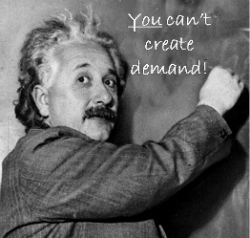Corporations, hungry to increase top and bottom lines, are always on the hunt for ways to streamline the process of attracting prospects, converting them to customers, and retaining them as repeat customers. Some CEOs have deployed marketing-automation software for this purpose, with mixed results.
Consultant David Raab forecasts that vendors of marketing-automation software will realize $750M in 2013 revenues; he predicts slow industry growth — mainly because the software is too generalized for all companies and doesn’t cure enough of their marketing woes.
One key component of marketing-automation software, the front end, is demand generation. To promote and explain the workings and virtues of demand generation, its purveyors and specialized industry consultants offer videos, seminars, webinars, and white papers. In my experience, whenever a product spawns a seminar industry, its value is questionable.
Exactly what is demand generation?
According to Eloqua, a marketing-automation vendor and recent Oracle acquisition, demand generation is:
… the art and science of creating, nurturing, and managing buying interest in your products and services through campaign management, lead management, marketing analysis, and data management.
Replacing actual human behavior with “Digital Body Language,” Eloqua adds: Today’s buyer acquires [his] information online, through various sources, on a timeframe that makes sense to [him]. Because of this, marketers must focus on understanding the needs of the buyer and facilitating [his] buying process, rather than pushing marketing messages at [him].
Marketo, also in the marketing-automation space, defines demand generation thusly:
… the evolution of traditional lead generation and an important subset of inbound marketing. Unlike traditional programs that throw any lead over the wall to sales, it is about qualifying and prioritizing prospects, nurturing a steady crop of qualified leads that want to engage with sales, aligning marketing with sales, and measuring and optimizing the results over time.
NEWSFLASH: Demand generation is oxymoronic.
 The dictionary definition of generate: to bring into existence; cause to be; produce. A marketer can’t bring demand into existence, cause it to be, or produce it — i.e., “generate” demand. It seems the bloke who coined this oxymoronic term never made a face-to-face sale, which requires skills in attracting, qualifying, gauging, persuading, and negotiating.
The dictionary definition of generate: to bring into existence; cause to be; produce. A marketer can’t bring demand into existence, cause it to be, or produce it — i.e., “generate” demand. It seems the bloke who coined this oxymoronic term never made a face-to-face sale, which requires skills in attracting, qualifying, gauging, persuading, and negotiating.
In this impersonal age of text messaging and social media, human disconnection rules. The art of direct, genuine communication is dying; knowledge of human emotions is rare — clearly reflected by the jargon and technologies companies employ to engage prospects.
The vendors above assume they either can create (generate) demand, or that it simply will materialize if enough buying levers exist. Following that, the strategy is to use automation, akin to an assembly line, to manage and measure the lead-to-sale process.
Demand neither simply materializes, nor can anyone generate it.
Eloqua disdains “pushing marketing messages” at customers, admonishing marketers to focus instead on understanding their needs. Seriously? An arrow without an arrowhead? The brand (marketing message) is the arrowhead. How else can one hit the target?
This common error — discounting or disregarding the brand — is precisely the problem: It repels demand, is the seed of white noise, and no technology can fix it. Only those few who understand customers’ needs and are proven wordsmiths can fix it.
Message Always Pulls Megaphone
Without a strong brand (marketing message), what will attract customers? If you think it’s your product, think again. Of course, there’s always that option to build an overly expensive salesforce, whose members will invent their own marketing messages — to your detriment.
Most firms, regardless of industry, look alike because their so-called “marketing messages” fail: they’re jargon-filled, unfathomable product statements, which turn off customers. A bad marketing message (brand) is verification that the marketer behind it neither understands customers’ needs nor how to articulate them.
Example of a bad brand (marketing message): We make the fastest, cheapest, smallest, most-ubiquitous, easiest-to-use widget in the world.
BRAND ATTRIBUTE YES NO Unique? X Evocative? X Succinct? X Memorable? X Repeatable? X
Customers loathe and reject such typically generic white noise — causing them to view vendors alike and products alike, and make price-driven purchases.
Rather than fix bad messages, many marketers default to social media and email blasts — nonsensical and a huge mistake: sending white noise through a megaphone begets louder white noise. On the other hand, strong marketing messages (brands) — which the audience can grasp in 15 seconds — can articulate customers’ needs, in their language, and are the key to attracting them.
In The King’s Speech, Colin Firth deftly portrayed King George VI, whose speech impediment rendered him almost unable to communicate to his British subjects. The entire movie (a true story) was about his struggle to overcome this problem. His solution was not to improve PA systems, microphones, or the radio network; it was to improve his speaking skills. Message always pulls megaphone, just as horse always pulls cart.
Attitude, Focus, and Activity
In 1989, I wrote “The Mystery of Marketing,” in which I asserted:
 “A market is akin to energy: it can be neither created nor destroyed. Marketers don’t have that power, although many think they do. The best marketers can do is discover, ignore, cultivate, exploit, manipulate, anticipate, excite, compete for a market — but never create it. Why? Because a market is people: their money, logic, and emotions. They already exist.”
“A market is akin to energy: it can be neither created nor destroyed. Marketers don’t have that power, although many think they do. The best marketers can do is discover, ignore, cultivate, exploit, manipulate, anticipate, excite, compete for a market — but never create it. Why? Because a market is people: their money, logic, and emotions. They already exist.”
Like energy and markets, demand already exists. One can anticipate, discover, stimulate, cultivate, channel, and compete for demand — but never create (generate) it.
Words matter. Words dictate attitude, focus, and activity.
Those who wrongly believe that a product is a market will focus on — you guessed it — the product. Likewise, those who hubristically believe they can create demand will focus on the product and fail at branding. Producting and marketing are mutually exclusive.
Rx from the WhiteNoise Doctor™
The way to fix demand generation is to scrap it altogether. Demand already exists; the best you can do is to “guide” it in your direction — no small task.
NOTE: Those surgically attached to keyboards and obsessed with social media never will grasp this axiom, so don’t put them in charge of branding. Digital body language? Are you kidding, Eloqua?
Replace “generation” with stimulation or cultivation, or both. Demand stimulation/cultivation. World of difference! Now, you can create a marketing message (brand), based on customer needs, and eliminate impersonal, anti-social, demand-repelling technologies — this includes marketing-automation software, if necessary. Don’t be a blind trend-follower.
Words matter. Using accurate words will drastically shift attitude, focus, and activity. Who benefits? Your customers, your company, and your shareholders. Nothing else matters.
© 2013 Marc H. Rudov. All Rights Reserved.
About the Author

Marc Rudov is a branding advisor to CEOs,
producer of MarcRudovTV, and author of four books

